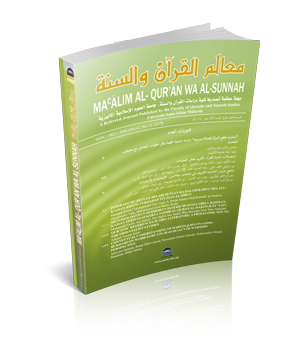الفرق بين كلمات الإنسان، النّاس، وبني آدم في استعمال القرآن الكريم
The Difference Between the Terms Insān, al-Nās, and Banī Ādam in the Usage of the Holy Quran
DOI:
https://doi.org/10.33102/jmqs.v21i1.543Keywords:
Insān, Al-Nās, Bani ĀdamAbstract
This study aims to demonstrate that although the Holy Quran was revealed in the Arabic language, it employs Arabic vocabulary in a distinct and nuanced style. One hardly finds in the Quran what can be considered true synonyms; rather, words that appear synonymous are often used with precise and differentiated meanings. This is evident, for instance, in the use of the terms insān (human), al-nās (people), and banī Ādam (children of Adam). At first glance, these words may seem interchangeable, but a closer examination reveals that the Quran applies each term in its own unique context and with specific connotations. This study employs both inductive and analytical methods. By selecting and examining these three terms, the researchers seek to establish that insān, al-nās, and banī Ādam each carry distinct meanings within the linguistic and thematic framework of the Quran.
References
Al-Qur’an Karim
Abdul Baqi, Mohammad Fuad. Mu’jam al mufahris Li alfāz Al Qur’an, Cairo: Dār al-Hadis, Ed.3, 1411H.
Al-Isfahani,Arrageeb. Mufradāt Alfāz al-Qur’an. Beirut:Dar Al-Shāiyyah, ed,2, 1418H.
Al-Tabari, Muhammad ibn Jarīr. Jāmi’ al-Bayān ‘an Ta’wīl Āy al-Qur’an. Beirut: Dār al-Fikr, Ed.5, 1400H.
Ibn ‘Āshūr, Muhammad Ṭāhir. Al-Tahrīr Wa al-tanwīr. Tūnus: Al-Dar Al-Tunusia L al-Nashr, 1984M.
Ibn al-Jauzi, Abdul Rahman bin Ali. Zād al-Masīr Fi ‘Ilm Al-tafsīr, Birut: Dār al-Kitab al-Arabiyy, ed.1, 1422H.
Ibn Kathīr, ‘Imād al-Dīn Abu al-Fida’ Ismail. Tafsīr Al-Qur’ān Al-Azīm. Madīna Al-Munawwarah: Maktabah al-Ṣafa, 1413H.
Muhammad, Al Ṣābūni. Safwah al-Tafāsir. Cairo: Dar Al-sabuni, n. d.
Downloads
Published
How to Cite
Issue
Section
License
Copyright (c) 2025 Abdoul Karim Toure, Mesbahul Hoque

This work is licensed under a Creative Commons Attribution 4.0 International License.
The copyright of this article will be vested to author(s) and granted the journal right of first publication with the work simultaneously licensed under the Creative Commons Attribution 4.0 International (CC BY 4.0) license, unless otherwise stated.
Authors are able to enter into separate, additional contractual arrangements for the non-exclusive distribution of the journal's published version of the work (e.g., post it to an institutional repository or publish it in a book), with an acknowledgement of its initial publication in this journal.
Authors are permitted and encouraged to post their work online (e.g., in institutional repositories or on their website) prior to and during the submission process, as it can lead to productive exchanges, as well as earlier and greater citation of published work.









